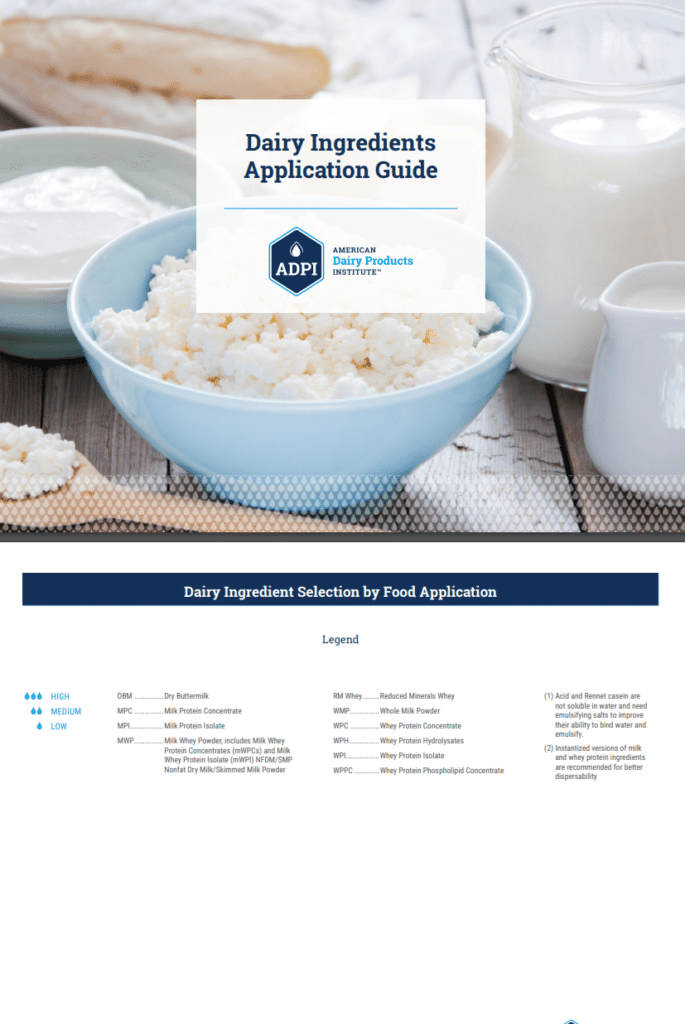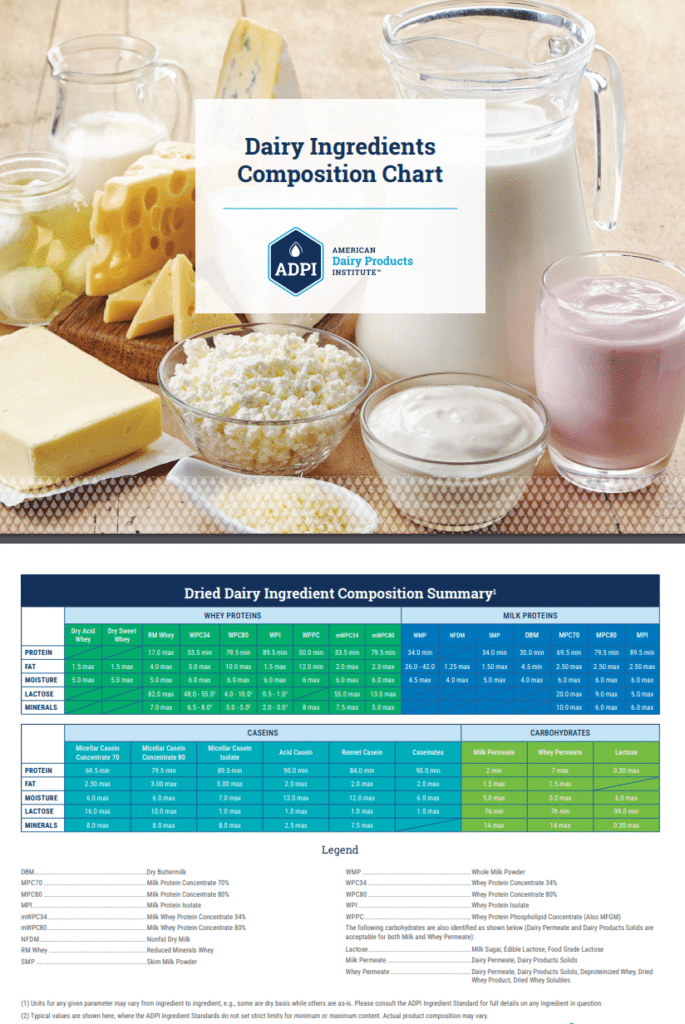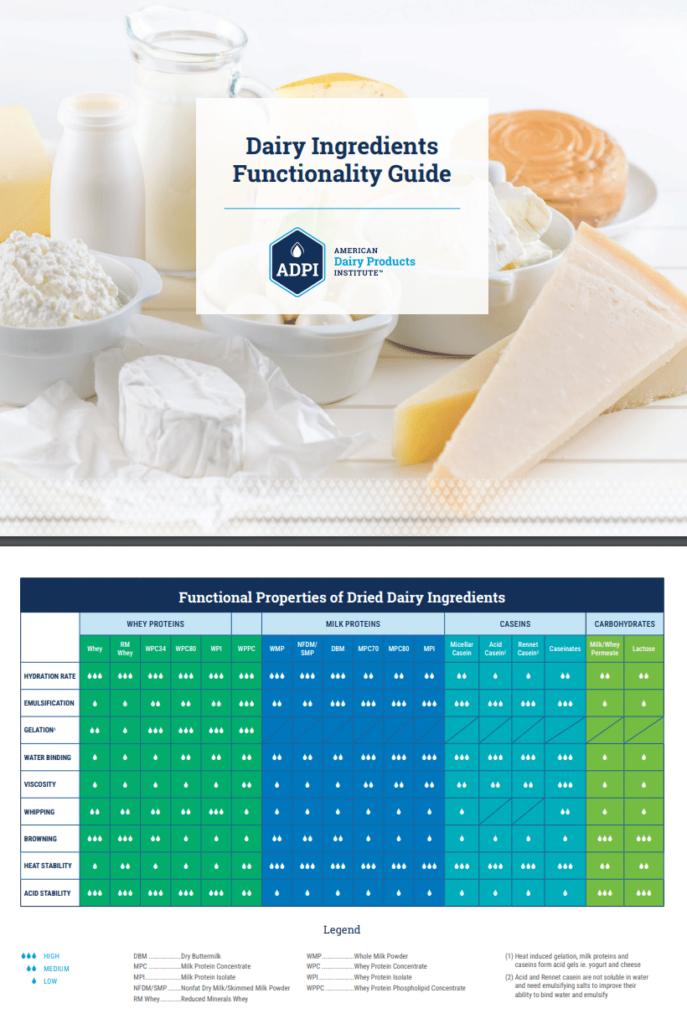Resource &
Knowledge Center
Whey Ingredients
Whey Ingredients
MILK INGREDIENTS
CARBOHYDRATE INGREDIENTS
milkfat Ingredients
Whey | Overview

WheyLiquid obtained from cheese manufacture. More is a collective term referring to the serum or watery part of milk that remains after coagulation, which occurs primarily in the production of cheese and cottage cheese. The composition of wheyLiquid obtained from cheese manufacture. More varies considerably, depending on the milk source and the manufacturing process involved. But in general, wheyLiquid obtained from cheese manufacture. More is rich in lactose (milk sugar)White to creamy white crystalline product, possessing a mildly sweet taste. It may be anhydrous, contain one molecule of water of hydration, or be a mixture of both forms. It is manufactured from whey or permeate by evaporating, crystallizing, refining and then drying the lactose crystals. More, mineralsGenerally refers to elements other than carbon (C), hydrogen (H), oxygen (O) and nitrogen (N) that are found in dairy products. The term often is used interchangeably with salts and ash. More, vitamins, and “wheyLiquid obtained from cheese manufacture. More proteins.”
Grade “A” dry whey must be produced with Grade “A” whey in a Grade “A” plant. All other parameters for Grade “A” products are the same as “Extra Grade.”
Natural, functional, and high in nutrition, wheyLiquid obtained from cheese manufacture. More is the ingredient of choice for product developers. WheyLiquid obtained from cheese manufacture. More ingredients have applications in baked goods, beverages, confections, dairy foods, meat products, salad dressings, nutraceuticals, sauces, and soups—with new uses continuously being identified.
Definitions of Whey
Merriam-Webster: WheyLiquid obtained from cheese manufacture. More is “the… part of milk that is separated from the coagulable part or curd especially in the process of making cheese and that is rich in lactose, mineralsGenerally refers to elements other than carbon (C), hydrogen (H), oxygen (O) and nitrogen (N) that are found in dairy products. The term often is used interchangeably with salts and ash. More, and vitamins and contains lactalbumin and traces of fat.” [1]
United States Code of Federal Regulations (CFRThe Code of Federal Regulations (CFR) codifies the general and permanent rules published in the Federal Register by the departments and agencies of the Federal Government. Title 21 of the CFR is reserved for rules of the Food and Drug Administration. It can be accessed at https://www.accessdata.fda.gov/scripts/cdrh/cfdocs/cfcfr/cfrsearch.cfm More): “WheyLiquid obtained from cheese manufacture. More is the substance obtained by separating the coagulum from milk, cream, or skim milk in cheesemaking.”[2]
Codex AlimentariusGroup responsible for developing a collection of internationally adopted food standards aimed at protecting consumers’ health and ensuring fair trade practices in the food trade. More: “WheyLiquid obtained from cheese manufacture. More is the fluid milk product obtained during the manufacture of cheese, caseinProtein in milk that precipitates at pH 4.6. More or similar products by the separation from the curd after coagulation of milk and/or of products obtained from milk.”[3]
American Dairy Products Institute (ADPIAmerican Dairy Products Institute More): “WheyLiquid obtained from cheese manufacture. More is the liquid substance obtained by separating the coagulum from milk, cream, or skim milk in cheesemaking. Dry WheyFresh whey that has been pasteurized and contains all constituents, except water, in the same proportions as found in the original whey More is the substance obtained by the removal of water from wheyLiquid obtained from cheese manufacture. More, while leaving all other constituents in the same relative proportions as in wheyLiquid obtained from cheese manufacture. More.”[4]
While each of these resources defines “wheyLiquid obtained from cheese manufacture. More” slightly differently, they all have the following in common:
- WheyLiquid obtained from cheese manufacture. More is of dairy origin, meaning that it is ultimately, unequivocally derived from milk (cow’s milk, in the U.S.).
- Cheesemaking is the most common origin of wheyLiquid obtained from cheese manufacture. More.
- Before any further processing, the wheyLiquid obtained from cheese manufacture. More itself has a very particular nutritional profile consisting of dairy proteins, lactose, milkfat, vitamins, and milk mineralsGenerally refers to elements other than carbon (C), hydrogen (H), oxygen (O) and nitrogen (N) that are found in dairy products. The term often is used interchangeably with salts and ash. More.
Whey Products Standards
The wheyLiquid obtained from cheese manufacture. More processing industry initiated the development of standards for condensed and dry wheyFresh whey that has been pasteurized and contains all constituents, except water, in the same proportions as found in the original whey More and wheyLiquid obtained from cheese manufacture. More products immediately after the founding of the WheyLiquid obtained from cheese manufacture. More Products Institute in 1971.
U.S. Standards for Dry WheyFresh whey that has been pasteurized and contains all constituents, except water, in the same proportions as found in the original whey More that include both sweet- and acid-types now exist as a result of cooperative efforts between industry and government. Uniformity of product qualityFocus on doing things well and producing a product acceptable to consumers More is ensured through grade specifications that are universally accepted and understood.
ADPIAmerican Dairy Products Institute More task forces have developed industry standards for a number of additional dry ingredient products derived from wheyLiquid obtained from cheese manufacture. More. Through such standards, wheyLiquid obtained from cheese manufacture. More processors, and users/purchasers, have a clear understanding of product qualityFocus on doing things well and producing a product acceptable to consumers More and the basis upon which such has been determined. Questions relating to a product’s qualityFocus on doing things well and producing a product acceptable to consumers More thus may be eliminated by having standardized analytical test methods available to both buyer and seller and by referring these test results to specific grade standards.
Methods of analyses needed to accurately determine product composition, measure qualityFocus on doing things well and producing a product acceptable to consumers More, and ascertain compliance with grade standards, have been reviewed and approved by an Institute Committee of technical experts, and are compiled in each standard.
In addition, several wheyLiquid obtained from cheese manufacture. More products have received GRASGenerally recognized as safe More affirmation and GRASGenerally recognized as safe More Notification and are listed in the appendices of this section.
How to Choose Between a Milk or Whey Ingredient
Milk and wheyLiquid obtained from cheese manufacture. More ingredients provide multiple benefits to food products. These benefits are often described as flavor, function, and nutrition. They provide a mild, dairy flavor that blends well with many food products. Their composition can consist of multiple components such as, proteins (caseins and/or wheyLiquid obtained from cheese manufacture. More proteins), milkfat, lactose, and ash (mineralsGenerally refers to elements other than carbon (C), hydrogen (H), oxygen (O) and nitrogen (N) that are found in dairy products. The term often is used interchangeably with salts and ash. More), and thus provides many different functional properties described in the table below. These components also provide many of the same unique nutritional properties found in milk.
Milk and whey ingredients are used in a wide variety of food products including dairy products, baked products, confections, soups, sauces, infant formula, processed meats, prepared foods, and beverages. Selecting the right dairy ingredient for your application can be confusing because many milk and wheyLiquid obtained from cheese manufacture. More ingredients have a similar composition, for example nonfat dry milk (NDMNonfat dry milk More) and whey proteinProtein in milk that remains in water phase after casein precipitates. More concentrate 34 (WPC34). Even though the protein content is about the same, NDMNonfat dry milk More consists of roughly 80% caseinProtein in milk that precipitates at pH 4.6. More and 20% whey proteinProtein in milk that remains in water phase after casein precipitates. More, while WPC34 is all whey proteinProtein in milk that remains in water phase after casein precipitates. More. Often the choice is made based on price, but comparing the differences in functionality is probably the most important method of selection.
SolubilityAbility of a liquid to dissolve another material. Examples: Lactose dissolving in water, alcohol dissolving in water. More in water is the single most important functional property for a milk or wheyLiquid obtained from cheese manufacture. More ingredient. No matter which ingredient you choose, it must be soluble for it to be functional. The solubilityAbility of a liquid to dissolve another material. Examples: Lactose dissolving in water, alcohol dissolving in water. More of a milk or wheyLiquid obtained from cheese manufacture. More ingredient that contains protein is impacted by the pHA measure of the acidity or alkalinity of a material. The pH scale ranges from 0 (acid) to 14 (alkaline) with 7 considered neutral. pH is a measure of the concentration of hydrogen ions and is defined as the negative log of the hydrogen ion concentration. More of the food. Milk protein ingredients have good solubilityAbility of a liquid to dissolve another material. Examples: Lactose dissolving in water, alcohol dissolving in water. More above pHA measure of the acidity or alkalinity of a material. The pH scale ranges from 0 (acid) to 14 (alkaline) with 7 considered neutral. pH is a measure of the concentration of hydrogen ions and is defined as the negative log of the hydrogen ion concentration. More 6.0. Whey proteinProtein in milk that remains in water phase after casein precipitates. More ingredients have good solubilityAbility of a liquid to dissolve another material. Examples: Lactose dissolving in water, alcohol dissolving in water. More at pHA measure of the acidity or alkalinity of a material. The pH scale ranges from 0 (acid) to 14 (alkaline) with 7 considered neutral. pH is a measure of the concentration of hydrogen ions and is defined as the negative log of the hydrogen ion concentration. More 3-7. Lactose, the main component in the ingredients lactose and milk/whey permeate (dairy products solids) has good solubilityAbility of a liquid to dissolve another material. Examples: Lactose dissolving in water, alcohol dissolving in water. More below a concentration of 14% in room temperature water, but has lower solubilityAbility of a liquid to dissolve another material. Examples: Lactose dissolving in water, alcohol dissolving in water. More (will crystallize) at refrigeration temperatures. The solubilityAbility of a liquid to dissolve another material. Examples: Lactose dissolving in water, alcohol dissolving in water. More of dairy ingredients that are high in calcium (such as milk/whey permeate), decrease with heat treatment and at a pHA measure of the acidity or alkalinity of a material. The pH scale ranges from 0 (acid) to 14 (alkaline) with 7 considered neutral. pH is a measure of the concentration of hydrogen ions and is defined as the negative log of the hydrogen ion concentration. More greater than 5. These are the primary characteristics to help select the right dairy ingredient for your application.
Functional Benefits of Milk & Whey Ingredients
| Function | Primary Components | Benefits |
|---|---|---|
| Solubility | Protein | Provides better performance in all applications |
| Browning | Protein and Lactose | Provides color and flavor development |
| Emulsification | Protein-caseins provide stronger emulsification than whey proteins | Provides binding and separation of fat globules and texture stability |
| Heat Stability | Protein-caseins are more heat stable than whey proteins | Prevents protein aggregation and settling for properly hydrated ingredients during high heat processing |
| Gelling & Heat Setting | Protein-whey proteins will denature and form gels with heat treatment | Provides structure and water holding properties |
| Water Binding & Viscosity Building | Protein-caseins have more water binding ability than whey proteins | Improves texture and mouthfeel; Helps to retain moisture and improve shelf life |
| Whipping & Foaming | Protein-whey proteins generally foam more than caseins | Provides aerated structure and texture |
Dairy Ingredient Application Guides
[1] www.merriam-webster.com
[2] 21 Code of Federal Regulations §184.1979
[3] Codex Standard for WheyLiquid obtained from cheese manufacture. More Powders, Codex STAN 289-1995, Codex AlimentariusGroup responsible for developing a collection of internationally adopted food standards aimed at protecting consumers’ health and ensuring fair trade practices in the food trade. More Commission, Joint FAOThe Food and Agriculture Organization (FAO) is a United Nations agency that works to improve food security and nutrition, and to end world hunger. More/WHO Food Standards Programme
[4] www.adpi.org/ingredient-resource-center/dry-whey




